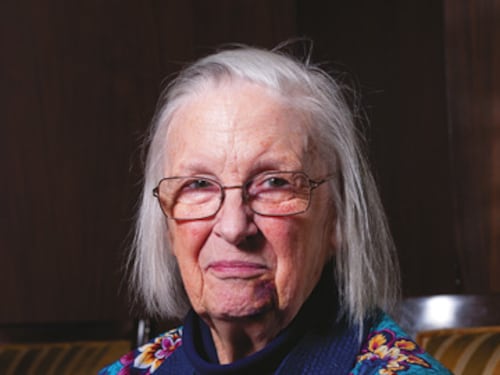Elinor Ostrom On Managing Common Property
Elinor Ostrom believes that the management of common property should depend on local circumstances, and not be based on one particular approach


Elinor Ostrom
2009 Nobel Laureate in Economic Sciences
Designation: Arthur F. Bentley professor of political science and Senior Research Director, Workshop in Political Theory and Policy Analysis, Indiana University, Bloomington. Founding Director, Center for the Study of Institutional Diversity, Arizona State University, Tempe
Education: B.A. (with honors), Political Science, UCLA, 1954 M.A., Political Science, UCLA, 1962
Ph.D., Political Science, UCLA, 1965
Work: Ph.D dissertation on Public Entrepreneurship—A case study in ground water basin management. Groundbreaking studies in managing common resources and services such as water, forests, fisheries
Gujjar herdsmen of Mangar believe that Gudariya Baba’s wrath will befall anyone who cuts trees from Mangarbani—a sacred grove of about 600 acres at the edge of their village. They say someone once took firewood from the forest, but his kitchen caught fire. The belief that the hermit Gudariya’s spirit protects the forest of largely slow-growing dhau trees, has kept human interference away.
It is said that most of the flora and fauna-rich grove, on the rocky slopes of the Aravallis, the oldest mountain ranges in the world, has remained largely undisturbed for hundreds of years.
Elinor Ostrom is hardly the person who would believe in such protective spirits. The spry-at-78 Arthur F. Bentley professor of political science at Indiana University, however, backs Mangar villagers and conservationists because she does believe in the durability of traditional community-based models of preserving and judiciously using common resources such as water, fisheries and forests.
Many decades ago while working on her dissertation, Ostrom found fascinating evidence of cooperation, problem solving ability and long-term vision of local communities in her native California. Her inquiry into how citizens had come together in western California to protect the city’s groundwater resources from increasing salination and replenishing them with fresh water eventually affirmed her belief that when faced with problems, local communities will find sustainable ways to manage common resources.
Californians formed rules and governing structures for managing the water and the systems have endured generations. Ostrom found examples of enduring community management across the world such as irrigation systems in Nepal and small and large police departments across America.
Ostrom used mathematics and game theory to disprove the notion of the tragedy of commons popularised by wildlife biologist Garrett Hardin in the 1960s. He postulated that common resources such as grazing land and fisheries will be degraded as communities will overuse them. The only solution to prevent that seemed to be privatisation. Ostrom’s work conclusively proved that privatisation, market-based approaches or government control did not necessarily help in effectively managing common resources, and won her the Nobel Prize for economics in 2009. Perhaps it was the solidity of her argument that even Hardin later corrected his view to the “tragedy of unmanaged commons’’.
Debating and questioning became second nature to Ostrom when in school she was put on the debate team to correct her stammering.
Her interest in public policy led her to political science at university. Ostrom, however, met with resistance when she tried to enroll for a Ph.D as graduate school remained a male domain in those days.
“I fought them,’’ Ostrom told Forbes India. Eventually she won and rose to become the head of the department and co-founder of Center for the Study of Institutions, Population and Environmental Change at Indiana University.
At graduate school, Elinor also met her future husband Vincent Ostrom with whom she developed the idea of polycentricity.
The couple believes that common property cannot be managed by private hands, or the market, or the government or even communities. But depending upon the local circumstances, any or many of those approaches could be the answer. “It is a system in which small, medium and large-scale all work together,” Ostrom says. “In India, which has a federal system, most good solutions would be polycentric.”
Ostrom’s research is particularly important for India which is struggling to manage its commons, be it forests or water. Flashpoints are becoming frequent as demands of a burgeoning population and its development needs put pressure on common property. The 600-acre Mangarbani, for instance, falls within Faridabad’s new 20-year development plan that would allow construction and other projects in eco-sensitive areas. But what they fail to grasp is that the forests are crucial to the maintenance of an ecosystem that helps recharge the aquifers beneath the Aravalli hills.
The Aravallis’ tail-end cuts across Delhi in the form of a ridge whose trees keep the capital green and quartzite rocks replenish pure groundwater.
The ridge is protected by law and government. In the urban sprawl of Delhi, it would be foolhardy to expect communities to protect the hundreds of kilometres along the ridge. But Mangar’s history has shown that if the villagers are left alone, the forest will not only remain pristine, but perhaps expand naturally. That is polycentricity at work where the government’s might and the community strength together protect a common resource for the larger good. Ostrom’s work is just that—mathematics and game theory providing theoretical underpinnings to what she physically observed on the field.
First Published: Mar 01, 2012, 06:09
Subscribe Now